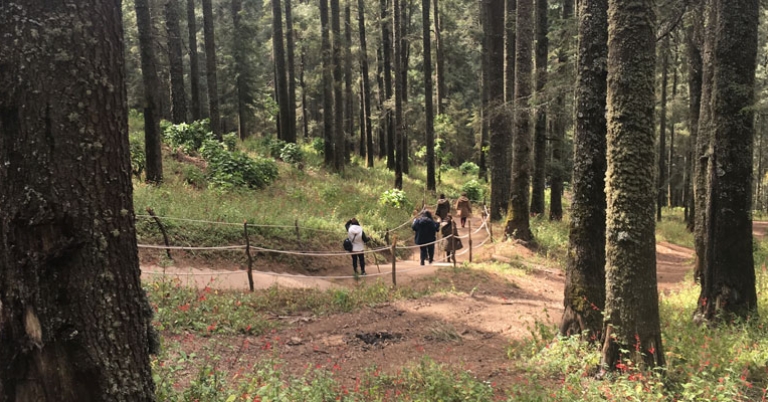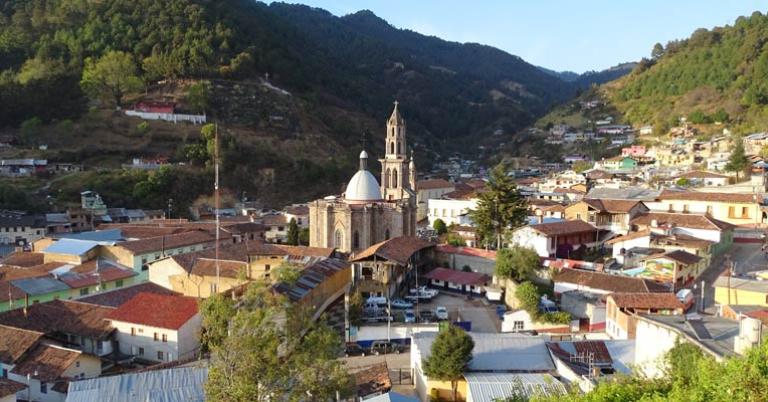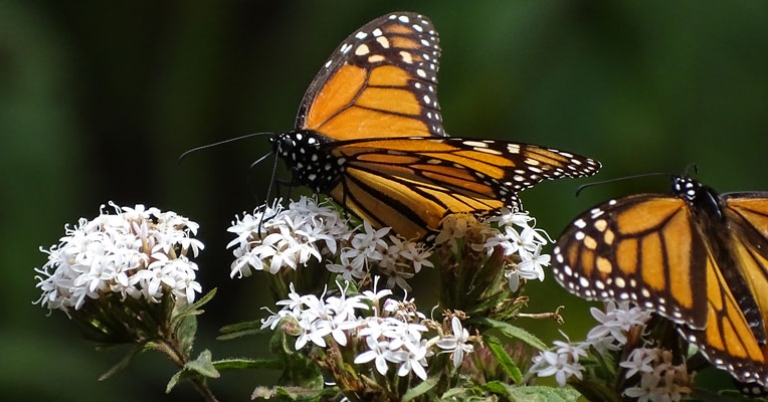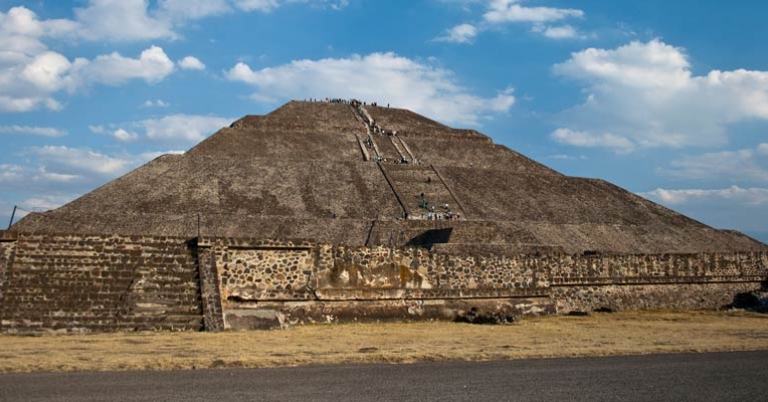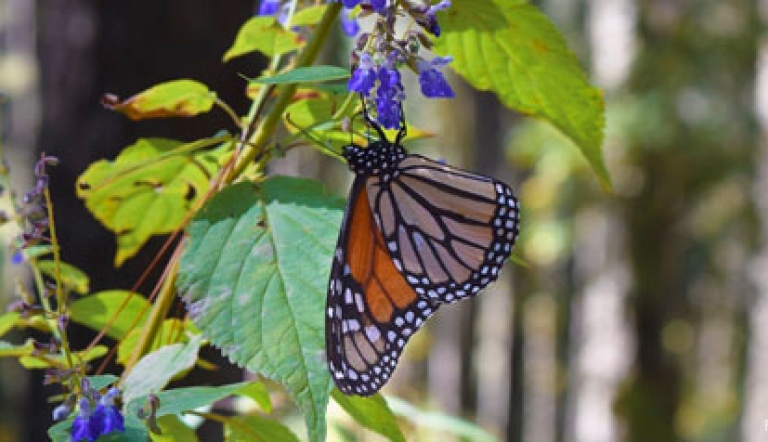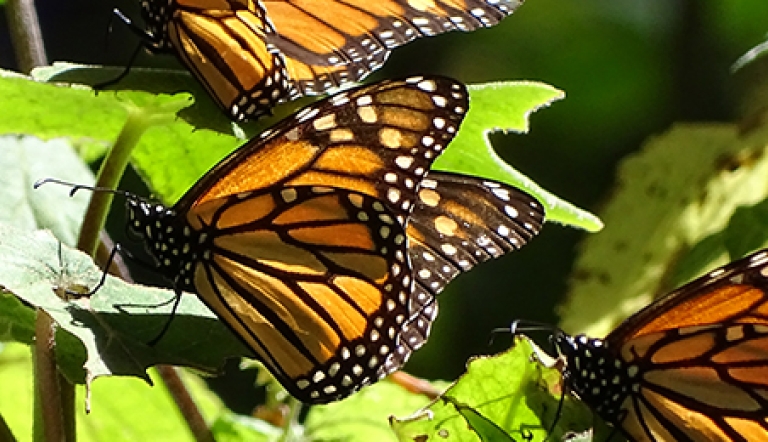Mexico | Mystical Migration of the Monarch Butterfly
About this trip
 One of the most amazing phenomena in nature is the annual migration of Monarch butterflies (Danaus plexippus) southward from their breeding grounds in the United States and Canada to overwintering sites high in the mountains of southern Mexico. Hundreds of millions of Monarchs fly along the Gulf Coast, or across the Gulf of Mexico, to eventually reach the belt of high volcanic mountains which stretches across the southern end of the central Mexican plateau. At about a dozen isolated places within the highaltitude forests of this zone, Monarchs pass the winter in aggregations that can exceed 2 billion individual butterflies. Join Cable Natural History Museum on a 7-day journey to witness this awe-inspiring spectacle firsthand as the monarchs flutter, dip, and swoop overhead.
One of the most amazing phenomena in nature is the annual migration of Monarch butterflies (Danaus plexippus) southward from their breeding grounds in the United States and Canada to overwintering sites high in the mountains of southern Mexico. Hundreds of millions of Monarchs fly along the Gulf Coast, or across the Gulf of Mexico, to eventually reach the belt of high volcanic mountains which stretches across the southern end of the central Mexican plateau. At about a dozen isolated places within the highaltitude forests of this zone, Monarchs pass the winter in aggregations that can exceed 2 billion individual butterflies. Join Cable Natural History Museum on a 7-day journey to witness this awe-inspiring spectacle firsthand as the monarchs flutter, dip, and swoop overhead.
Highlights
- Hike or ride horseback to two different monarch reserves in Michoacán, where millions of individual monarch butterflies gather.
- Photograph the dramatic colors of the butterflies as they hang in clusters from the trees, drink from streams, feed on wildflowers, and soar in the air above.
- Visit the pyramids at Teotihuacán, one of the most architecturally significant Mesoamerican sites of pre-Columbian times.
- Spend time exploring colonial Angangueo, which was once a mining town but now derives most of its livelihood from butterfly ecotourism and agriculture.
Meet your leader
 Emily M. Stone
Emily M. Stone
Emily M. Stone is a naturalist by birth, training, profession and passion. Her childhood spent as a “mud and water daughter” in northeast Iowa led to a degree in outdoor education from Northland College and a Field Naturalist Masters from the University of Vermont. As the Naturalist/Education Director at the Cable Natural History Museum in Cable, Wisconsin, Emily writes a weekly “Natural Connections” column published in more than a dozen local and regional newspapers.
$2,735
Per person
About this price
Land cost only. Does not include round-trip airfare to and from destination.
Single room supplement $490
What makes us different
Wildlife up-close
Cultural Discovery
Expert guides
Flight arrangements
Service anytime
Sustainable travel
Daily Itinerary
Print ItineraryMexico City
Angangueo
Angangueo
Jungapeo
Jungapeo
Mexico City
Pricing
Print Pricing$2,735
Per person
About this price
Land cost only. Does not include round-trip airfare to and from destination.
Single room supplement $490
What's Included
- Activities and meals as mentioned in itinerary
- Carbon Offset
- Full time naturalist guide/driver for duration of the program
- Private transportation and driver for the duration of the program
What's Not Included
- International airfare
- Tips
- Travel Insurance
Pricing Details
A $200 per person deposit and enrollment form is due to hold your space on this trip. The deposit is refundable less $100 cancellation fee until 95 days prior to departure. Cancellations after this date will result in loss of full deposit.
Cancellations after this date will result in loss of full deposit.
Holbrook Travel strongly recommends the purchase of travel protection for medical emergencies while traveling and to protect your investment. Please note the purchase of Cancel for Any Reason Coverage or to exclude pre-existing conditions with Trip Cancellation coverage may require policy purchase within 10-14 days of your initial deposit, depending upon the provider.
Single room supplement $490
Final payment due date: August 28, 2022
Travel Info
Print Travel InfoActivity Level
This is an active adventure in high-altitude conditions (over 10,000 feet). Participants should be in good health and able to hike for a distance of 2-3 miles to the colony site and then back the same way (could be around 5 miles of hiking in one day). Typically, the hike takes between one and two hours, but the colony site varies throughout the season, so hiking times and distances may vary.
Entry & Exit Requirements
U.S. citizens must have a valid passport to enter Mexico. Passports must be valid for at least the duration of your stay. As this requirement is subject to change at any time without notice, we recommend at least 6 months’ validity. A passport card is not acceptable for entry to the U.S. by air.
Travelers no longer need to fill out the Forma Migratoria Multiple (FMM), also known as the tourist card, if flying in and out of the following airports: Mexico City International Airport (MEX), Cancun International Airport (CUN), Cozumel International Airport (CZM), Los Cabos International Airport (SJD), or Puerto Vallarta International Airport (PVR).
If you are flying in and out of an airport other than those listed above, Mexico still requires submission of an immigration form (tourist card) upon arrival. There is no fee for the form, but it is recommended that you complete the form online at https://www.inm.gob.mx/fmme/publico/en/solicitud.html and print it prior to your departure. While the form will also be available upon arrival, printing the tourist card prior to your trip will expedite your arrival process. For more information about the tourist card, visit https://www.mexicotouristcard.com.
If you are not traveling with a U.S. passport, please check with the Mexican Embassy for the requirements based on your nationality.
Health Information
IMMUNIZATIONS
The Centers for Disease Control recommends that all travelers be up to date on routine vaccinations such as measles-mumps-rubella (MMR) vaccine, diphtheria-pertussis-tetanus vaccine, varicella (chicken pox) vaccine, and your yearly flu shot before every trip.
There are no vaccinations required for entry into Mexico. The CDC recommends inoculation against hepatitis A, hepatitis B, and typhoid for most unvaccinated travelers to Mexico.
Please consult your physician for additional information and recommendations based on your individual circumstances.
MALARIA
The CDC does not consider travelers to Mexico City or the Mexican state of Michoacán to be at risk for malaria.
Dengue Fever & Other Insect-borne Illnesses
Locally transmitted cases of dengue fever have been reported in Mexico. Local transmission means that mosquitoes in the area have been infected with the virus and are spreading it to people. In addition, locally transmitted cases of leishmaniasis, Zika virus, and other insect-borne illnesses have been reported in Mexico.
There are no vaccinations available to protect against dengue, leishmaniasis, or Zika. The CDC recommends that travelers to Mexico protect themselves against insect bites. Cover exposed skin with lightweight, long-sleeved shirts and pants, consider treating clothes with permethrin, and use an insect repellent containing an active ingredient like DEET or picaridin. Apply sunscreen first, followed by the repellent (preferably 20 minutes later). As a precaution, the CDC advises women who are pregnant to consider postponing travel to any area where Zika virus transmission is ongoing.
Altitude Sickness
At elevations above 5,000 feet, altitude sickness is a possibility. Stay hydrated and well-rested, and avoid heavy, fatty foods and alcohol in the days before arrival. Consult your physician prior to travel for advice specific to your situation.
Travelers’ Diarrhea
The CDC warns that travelers’ diarrhea is the most common travel-related illness. Consumption of contaminated food and water may cause diarrhea. To avoid this, do not drink tap water, and use bottled water to brush your teeth. Avoid ice and uncooked vegetables or fruit without a peel. When in doubt, ask your guide. Restrict yourself to cooked food at restaurants, and avoid food sold on the streets. If you contract diarrhea, it is very important to drink large quantities of purified water. Consult your doctor for appropriate medication should you contract diarrhea.
SUN EXPOSURE
The effects of the sun can be damaging to the eyes and skin. Spending time outdoors exposes you to the sun’s harmful ultraviolet (UV) rays, even on cloudy days. To protect yourself from the sun, use a broad spectrum sunscreen of at least SPF 15, protect skin with clothing, wear a wide-brimmed hat and sunglasses, and drink plenty of fluids.
Additional Notes
Please note that this program visits the Mexican state of Michoacán, which the US State Department has long designated a level 4 due to criminal activity. The state of Mexico City is a level 2. You are advised to visit https://travel.state.gov for more information. Holbrook Travel has safely operated this trip for over 20 years.
During site visits, the days entail walking around the butterfly sites on your own and photographing and watching butterflies. Please be prepared to be independent during butterfly watching. Bathroom access is at the base of the mountain and can be reached by walking or renting a horse. There are also vendors at the base selling food, beverages, and local crafts. Dressing in layers is important due to weather at mountain elevations. Please be advised that Hotel Don Bruno does not have a heating system. It can be cold at night so warm sleeping clothes are recommended.
Resources
Print ResourcesSuggested Packing List
Everyone has personal preferences when it comes to packing; for this reason, the information below is offered as a general guide and not a definitive list. You know yourself best: Use your discretion and pack what you think will serve you, based on your personal preferences and specific itinerary. You may find many of these items in our Gear Store.
CLOTHING
Note: Field clothes are fine at the hotel in Angangueo. The trails can get dusty, so a bandana may be helpful. You may want nicer (casual) clothing for Mexico City and Teotihuacán.
- Clothing in layers, suitable for peeling off as the temperature may warm to 60-70 degrees on each day but become colder at night and early morning (32 degrees at sunrise, typically). Long pants (blue jeans, khakis, slacks), T-shirts, and long-sleeved shirts are all fine for the days on the mountain and while at the hotel in Angangueo. In Mexico City, you can wear what you traveled in on the plane or similar attire (no suit, coat or tie needed; no special formal dress needed).
- Long underwear: May be useful at night in Angangueo as the hotel rooms are unheated and could get rather cold
- Parka or other outerwear: The temperature in the Sierra Chincua may be near freezing for the first hour or two. Gloves and a wool hat are recommended. Do at least wear a cap or other hat. Rain is not anticipated, but raingear is a great layer, should there be a slight snowfall.
- Rain gear: It very rarely rains, but it’s always best to have a backup plan, should a slight drizzle or snow flurry occur. It also makes a great layer for added warmth.
- Warm pajamas: The rooms in Angangueo are not heated and can get down into the 30-40 °F range during cold snaps.
- Wool hat
- Gloves and hand warmers: Retail stores such as Target or Walmart sell disposable hand-warming pouches that last for hours and are very helpful during the chilly mornings.
- Comfortable, well-worn shoes with rubber soles: Shoes should be suitable for walking on cobblestone streets, gravel paths and uneven, damp surfaces.
- Hiking boots: For dusty forest trails or riding horseback (if desired)
MISCELLANEOUS
- Sunglasses and sunscreen: There is a chance for sunburn when on the mountain, as well as at Teotihuacán, where temperatures may be as high as 80-90 degrees. Please bring sunscreen for your protection.
- Medicines/Toiletries: Bring aspirin or similar in case of altitude headaches. We do not anticipate exposure to dysentery-causing bacteria, but you may wish to bring an antidiarrheal like Lomotil or an antibiotic such as Cipro (see your physician for a prescription) if you are sensitive to food and water changes. Always drink bottled water or bottled drinks, or treat your own water bottle with iodine tablets for drinking water in the field throughout the trip.
- Soap, shampoo and washcloths are not always found in hotels outside of the U.S., so you may wish to bring these with you.
- Daypack or knapsack: To carry a pack lunch, water, camera gear, rain gear, clothing layers, etc.
- Camera equipment and extra batteries/memory cards. Be prepared to pay an extra park fee for use of a video camera (anything that looks professional-level) while in the parks.
- Personal water bottle: Plan to buy bottled water, but you may wish to bring an extra container for refilling.
- Travel alarm clock
- Pocket calculator or cell phone for currency conversion
- Toilet paper or travel tissues (as it may not be available at all stops)
In addition to your toiletries, it is useful to pack a small medical kit. Helpful items include bandages, insect repellent, antihistamine, a pain-reliever, individually wrapped moist towelettes, anti-diarrhea medicine, anti-fungal cream, a small sewing kit, and an extra pair of disposable contact lenses or eyeglasses if you wear them.
Additional Packing Tips
Please make sure to bring warm clothes, as the temperatures at 10,000 feet can be at or below 30 °F in the morning. Layering is encouraged, as the mid-day temperatures may be in the 60s or 70s in December. At Teotihuacán, it will likely be 80-90 degrees. Versatility is key.
You may also wish to pack long underwear, as the hotel rooms in Angangueo will not be heated and temperatures may be in the low 60s to mid-50s at night and the early morning. Hotel staff provide heavy blankets, but fleece pajamas (or long underwear) and warm socks will keep you extra cozy.
Hand warmers are small, heated pouches found in outdoor sections of many large retail stores as well as specialty sports and camping stores. When you open their packaging, the oxygen reacts with the powder inside the pouches to create heat, and after about 30 minutes they heat up to 120 degrees, last for about 6-10 hours, and provide considerable warmth. They come in a variety of sizes and are very inexpensive (less than $1 each). These have been very popular with people in the past and are another way to ensure that you are comfortable during the cool mornings and nights. Due to current security regulations at airports, we recommend you pack these in your checked luggage, NOT your carry-on luggage.

Questions
Contact Kevin Van Dien at kevin@holbrooktravel.com or Emily Stone at 715-798-3890 or emily@cablemuseum.org.

